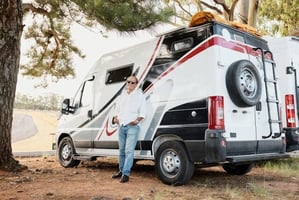Towing a trailer isn't just about hitching and hitting the road.
It's about control, preparation, and confidence—especially when you're hauling something valuable. Whether you're towing an Airstream across the country or hauling tools to a job site, the difference between a smooth trip and a stressful one often comes down to the small things.
How do you stay safe when you're towing thousands of pounds behind your vehicle?
What can you do before, during, and after your journey to ensure everything runs as it should?
From hitch selection to highway driving techniques, this guide will help you cover all the bases and avoid the most common towing mistakes. Because the more you know, the safer and more confident you'll feel behind the wheel.
If you want greater control and virtually zero sway, many experienced haulers trust the ProPride 3P® Hitch—a premium sway-control system designed to keep your rig rock-steady, even on gusty highways.
In this blog, we will cover:
- How to manage trailer weight and avoid overloading
- The right way to hitch and secure your trailer
- Smart driving habits to adopt while towing
Let’s dive in!
Understanding Trailer Weight and Capacity Limits
A successful trip begins with knowing exactly how much weight you’re asking your tow vehicle to pull. Skip this step and you’ll invite brake fade, warped rotors, and white-knuckle sway.
Gross Vehicle Weight Rating (GVWR) in Plain English
Think of GVWR as the “do-not-cross” line. Add the trailer’s empty weight, cargo, fluids, and accessories—if the total tops that factory-stamped number, you’re in the danger zone. Exceeding GVWR stresses axles, frames, and—most critically—braking systems.
Tongue Weight: The Silent Stability Hero
Keep 10 %–15 % of the total trailer weight on the hitch ball. Less and the trailer can fishtail; more and your rear suspension squats, lifting the front wheels and ruining steering feel.
Quick Weight-Safety Checklist
- Locate GVWR on the trailer’s data plate.
- Verify your tow vehicle’s maximum tow rating in the owner’s manual.
- Visit a certified CAT scale to weigh the loaded rig.
- Shift heavy cargo so it sits directly above or slightly forward of the axle.
- Re-check tongue weight with a commercial tongue-weight scale.
Balancing these numbers sets the foundation for every other safety measure in this guide.
Choosing and Securing the Right Hitch
A hitch isn’t a one-size-fits-all bolt-on. Picking the wrong system is like running marathon miles in sandals—possible, but painful.
Weight-Carrying vs. Weight-Distribution
|
Hitch Type |
Best For |
Key Benefit |
|
Weight-Carrying |
Small utility trailers under ~3,500 lb |
Simple, inexpensive |
|
Weight-Distribution |
Travel trailers, cargo haulers over ~3,500 lb |
Re-levels vehicle, tames porpoising |
Why Drivers Swear by the ProPride 3P® Hitch?
- Pivot Point Projection™ shifts the trailer’s pivot forward, giving you fifth-wheel-like stability on a conventional bumper pull.
- Built-in anti-sway devices stay active in crosswinds—no friction pads to “wear in.”
- Adjustable bars let you dial in weight distribution for varied loads.
Could a standard ball mount work?
Sure. But if zero-sway confidence sounds better, the 3P® is the gold standard.
Hitch-Up Must-Dos
- Match ball size to the coupler—never force a fit.
- Seat and latch the coupler fully; insert a locking pin.
- Crisscross safety chains under the tongue so they act like a hammock if the coupler fails.
- Plug in the seven-way connector and test brake lights, turn signals, and the electric-brake controller.
Pre-Trip Safety Checklist
Rushing through prep is tempting—but a ten-minute walk-around can stop hours of roadside headaches. Grab a notepad, set a timer, and tick these items off before every departure:
- Tires – Inflate to the PSI stamped on the sidewall when cold; inspect tread and sidewalls for bulges.
- Wheel lugs – Torque to manufacturer spec. Loose lug shear studs.
- Brakes – Test trailer brakes at five mph in a parking lot. Adjust the gain until you feel a firm, even tug.
- Lights – Verify headlights, brake lights, turn signals, and running lights. Clean dirty lenses.
- Suspension & Coupler – Look for cracked leaf springs, leaking shocks, or a coupler that won’t latch smoothly.
- Mirrors – Extend or add tow mirrors so you see at least one full lane on either side of the trailer.
- Breakaway Cable – Clip it to a solid part of the tow vehicle, not the safety-chain loops.
Finish by walking 360° around the rig. If anything looks off, fix it now, not on the shoulder later.
Loading and Weight Distribution Best Practices
Ever packed a suitcase that tips over the moment you let go? A trailer can do the same, just with far scarier consequences.
- Start Heavy, Centered, and Low: Place generators, toolboxes, or water jugs slightly forward of the axle. Low center-of-gravity items help the trailer track true.
- Balance Side to Side: Unequal side loads make you fight the steering wheel. Visual cue: step back and confirm the trailer isn’t listing left or right.
- Secure Everything: Use ratchet straps rated for the load. A flying cooler can punch a hole in fiberglass or smash the window of the car behind you.
- Re-Check After 50 Miles: Straps loosen, cargo settles. Pull over at a rest area and tighten as needed.
Dialed-in loading keeps sway at bay and reduces driver fatigue.
Driving Techniques for Safe Towing
Your tow vehicle just gained a 30-ft tail—and its personality changed. Treat it like a different beast.
Smooth Acceleration & Gradual Braking
Heavy rigs stretch stopping distances. Aim for double your normal following gap. Begin braking early and ease off the pedal to avoid jackknifing.
Wider Turns Without Cutting Corners
Swing the steering wheel a hair later than usual, then track wide. Watch your trailer wheels in the mirror—if they clear the curb, you’re golden.
Managing Downhill Grades
Shift to a lower gear before the descent. Engine braking takes heat off the rotors and keeps the trailer from pushing you.
Controlling Sway on the Fly
Feel a wiggle?
Hold the wheel straight, ease off the accelerator, and gently apply trailer-only brakes if your controller offers that function. If you’re using the ProPride 3P® Hitch, that wiggle rarely evolves into dangerous sway—another reason seasoned RVers swear by it.
Bad-Weather Wisdom
- Slow by 10 mph for rain, 20 mph for snow.
- Avoid sudden lane changes—trailers respond sluggishly on slick surfaces.
- Increase following distance even more since spray or snow reduces visibility.
Sticking to these habits transforms towing from tense to routine.
Handling Roadside Emergencies
No one plans for trouble, yet flat tires and mechanical gremlins ignore the best planning. Knowing what to do keeps a hiccup from becoming a hazard.
- Tire Blowout – Grip the wheel, coast straight, do not brake hard. Once slowed, signal and pull fully off the road before swapping the tire.
- Overheated Brakes – Smell burning? Shift down, lightly apply trailer brakes to share the load, and stop to let rotors cool.
- Coupler Failure – If safety chains are your last connection, activate four-ways, coast to a stop, and re-hitch or call roadside assistance.
- Electrical Loss – Carry spare fuses and a test light to diagnose a sudden brake-light blackout.
A calm, methodical response keeps you and fellow drivers safe.
Routine Maintenance to Keep Your Rig Road-Ready
- Every Trip – Inspect tires, lug torque, and breakaway battery charge.
- Every 3 Months – Lube hitch ball, coupler latch, and weight-distribution bars. Grease wheel bearings if you tow often in rain or dust.
- Annually – Pull drums, check brake shoes, replace worn magnets, and inspect suspension bushings.
- Every 5 Years – Replace trailer tires, even if tread looks fine. UV and age degrade sidewalls.
Consistent upkeep preserves resale value and—more importantly—your peace of mind.
Wrapping It Up
Safe towing isn’t a mystery—it’s a mix of proper prep, balanced loading, and thoughtful driving.
Nail your weight limits, secure a reliable hitch like the ProPride 3P®, run through a thorough pre-trip routine, and adapt your on-road habits. Do that, and every journey—whether a quick weekend getaway or a coast-to-coast adventure—feels confident and carefree.
Ready to feel the ProPride difference for yourself?
Explore the 3P® Hitch lineup and turn towing anxiety into towing assurance.
Frequently Asked Questions
When readers finish the how-to, they often have quick follow-ups—so here’s a rapid-fire roundup you’ll actually find helpful.
1. How do I calculate tongue weight without a commercial scale?
Use a bathroom scale and a sturdy block: place the scale under the jack, rest the coupler on a pipe to distribute load, and multiply the reading by the lever ratio. Aim for 10 %–15 % of total trailer weight.
2. Is sway control still needed with a lightweight trailer?
Even light rigs can fishtail in crosswinds or during sudden lane changes. A hitch with built-in sway control—especially projection-based systems—adds stability regardless of trailer size.
3. Can I tow in overdrive on long highway stretches?
It depends on transmission temps. Many modern vehicles allow overdrive towing on flat terrain, provided the transmission fluid stays cool. Install a temp gauge and downshift if temps climb toward the red zone.
4. What spare parts should I carry for a multi-state trip?
Pack a mounted spare tire, wheel-bearing kit, brake-controller fuses, extra light bulbs, and a basic tool roll. These small items solve most roadside delays without a tow-truck bill.
5. How often should electric-brake magnets be replaced?
Inspect magnets at every annual service. Replace when the friction surface shows deep grooves or the resistance reading falls outside manufacturer specs—usually every 10,000–12,000 miles for frequent towers.
6. Does weight distribution affect fuel economy?
Yes. A properly distributed load reduces aerodynamic drag and rolling resistance, helping the engine run in its optimal power band. Expect a modest mileage bump compared with a squatting, imbalanced setup.


